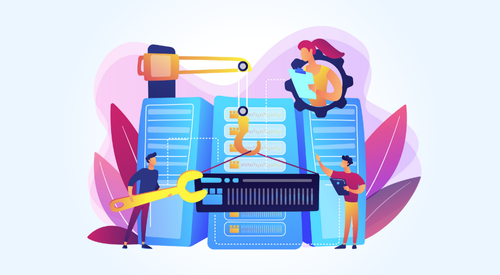

High availability for Apps is a critical component of any cloud application architecture. It ensures uninterrupted access to services and data, even in the face of hardware failures, network outages, or other disruptions. For mission-critical applications, downtime can have severe consequences for businesses, including financial losses, reputational damage, and customer dissatisfaction.
Optimize for Zero Downtime with Niveus
Cloud platforms like Google Cloud offer a range of tools and features to build highly available systems. At the core of Google Cloud’s infrastructure is the concept of zones, which are geographically isolated data centers equipped with redundant power, networking, and cooling systems. By strategically distributing virtual machines (VMs) across multiple zones, organizations can significantly enhance the resilience of their applications.
In the following sections, we will delve deeper into the principles of HA, explore various strategies for achieving it, and provide practical guidance for implementing HA solutions in self-managed VM environments.
Understanding HA Requirements and Scope
Before designing an HA solution, it’s crucial to have a clear understanding of the application’s specific needs. This involves a thorough assessment of various factors that will influence the HA strategy.
Determining HA Scope
One key contributor to developing a highly available solution is to identify the specific type of a workload. For instance, different workloads such as web servers, databases, batch processing are highly demanding and need varying levels of HA control.
- Location Identification: Whether zonal or multi-regional, HA is necessary is based on the criticality of the application and the user distribution. Zonal HA brings the stability of the data center to the region whereas multi-regional HA guarantees protection against the full region failures.
- Leg Latency: Modestly decreases the time it takes for data to travel over the network can pay big dividends in terms of application performance. By placing application components within the same zone or region, may be a significant contributor to the successful reduction of latency.
- Trail Balancing Solutions: It is the best approach is to map out all the various alternatives and their cost implications before making the final decision. Concepts of VM instance types, network egressing costs, as well as, storage options are the key factors that affect the final cost calculation.
- Resource Limitations: Realizing the fact of having a quota or limit from the region is so crucial to avoid a resource drain.
Through close examination of these criteria, we can start forming a specific application plan that can meet the right level of redundancy and cost-effectiveness.
HA Solutions for Self-Managed VMs
Achieving high availability for self-managed VMs requires a combination of strategies tailored to the specific application’s characteristics. By carefully considering factors such as workload type, data criticality, and performance requirements, you can implement effective HA solutions to minimize downtime and ensure business continuity.
Stateless Applications
Stateless applications, such as web servers or load balancers, are relatively easier to make highly available. The main ways to do it are:
- Load Balancing: Forward data across various valances or areas for more reliability.
- Autoscaling: Smartly handle the traffic and errors like an increase or decrease in the number of instances of the application through dynamic resizing.
- Multiple Availability Zones: Position instances in a way that they don’t all belong to the same zone. This way, in case of a failure zone, the load is relocated from the affected area to the surviving one.
When you make use of the synergy offered by these methods, there is a point where you reach both high availability and scalability for stateless applications.
Stateful Applications
Usually, stateful applications which include databases or stateful microservices, require more considerations because of the need for data consistency and availability. The usual strategies are:
- Replication: Replicate data from one to multiple instances to support & fault tolerance.
- High Availability Clusters: Apply the features of database HA or use third-party clustering solutions based on your preferences.
- Storage Redundancy: Employ redundant storage mechanisms in case of data loss occurrence.
The most important aspects of sustainable HA for stateful applications are careful planning and proper configuration.
Health Checks
Healthy health checks, the very foundation of an HA system, guarantee good health of the service. These checks, in particular, ascertain the availability and verify the responsiveness of each specific service instance. With the already mentioned ongoing health checks, users can quickly find unsuccessful instances and attach them to the system to keep running.
- Purpose: To find if the backend instances are healthy.
- Mechanism: Checks get sent to instances periodically and their availability gets back reported by their reaction/ response to the given problem.
- Action: Takes away the faulty instances from the load balancer pool to guarantee the forward to the stable ones.
Load Balancing
Load Balancers are an intermediate entity that smartly divert the info from clients to one of many destination servers or nodes; they must balance the incoming traffic across all available instances in the most beneficial way. Managing distributed systems and spreading the load of incoming requests among multiple servers is instrumental in easy and quick recovery as well as spare better handling of exceptional workload instances. Moreover, the layout of software-defined network technologies can be explained according to the specific layers of the network program.
- Distribution: Routes traffic across many instances on the basis of different algorithms i.e. round robin, least connections, and weighted.
- Fault Tolerance: Commodities become more dependent on the network load and the effects of outages due to more serious bound integration. But with load balancing, error handling, traffic will be redirected away from the unhealthy nodes preventing service degradation.
- Scalability: Enables horizontal scaling by adding or removing instances to accommodate changing load.
Some of the vital frequently overlooked details with respect to load balancers are the following:
- Global vs. Regional: Select the load balancer based on the regional coverage required by the High Availability of the Application.
- Protocol Support: Make the compatibility of the protocols you will use (e.g., HTTP, TCP, UDP) with the application assured.
- Session Affinity: Keep the session state in real time if stateful applications need to.
Integration and Redundancy
In order to guarantee that your High Availability solution is completely functional, the identification of the interrelated nature of various components is a must.
- Identify Single Points of Failure: Determine the weak points of your infrastructure to the best of your ability and point out any bottlenecks or dependencies that could make your system unavailable.
- Implement Redundancy: You add copies of things at different layers, aside from supervising, backup, and middleware, to construct a system that still functions in the presence of a failure.
In a perfect arrangement of health checks, load balancing, and redundancy, you can easily better the availability and reliability of the applications you have.
Autoscaling
Also, cloud computing and data storage form a high-availability solution, as they allow the business to balance the workload and optimize application performance accordingly. This process is hence, successful and automated ensuring resource capacity for the peak periods is always in plenty just like it should be.
- Unmanaged Instance Groups: These groups give the operators manual control over instance membership but fail to include the auto scaling function.
- Managed Instance Groups: They are groups that scale automatically according to generated metrics, which are mainly the pre-defined ones, and, thus, are very good for HA related problems
Storage
Moreover, storage is another vital aspect of HA. The storage infrastructure you select can have a significant impact on data durability and availability.
- Regional Persistent Disks (PDs): These disks are redundant across several geographical zones within the region, thereby ensuring that they do not fail even if the whole zone is down.
- Local SSDs: Although they are quite faster, technical faults can occur, therefore, be cautious enough to use them only for brief data or workloads that are not of any consequence.
- Regional PDs with Replication: To step up data protection, look for regional PDs with replication across multiple regions.
Locality
Network latency reduction will be the main priority in a few particular situations. The best method of doing this is by using placement policies to put the cases on the same physical rack so that they can be collocated. The applications here can be those that need top performance.
Rich combinations of these factors and the earlier-explored components, (health checks, load balancing) create cloud environments that are highly available and resilient.
Cross-Region Strategy
It is generally recommended to keep application components in the same region to get the best performance. Hence, cross-region replication is very important for situations like disaster recovery and ensuring business continuity.
- Regional Isolation (Priority): Make an extra effort to control the areas of application within the same region to ensure high performance and to reduce network latency.
- Cross-Region Failover: The measures ensure that in case of a region shutdown, the system fails itself over to another region automatically.
- Data Replication: Your option should be to duplicate the key information to other areas to avoid sudden data loss.
By carefully planning and implementing cross-region strategies, you can significantly enhance the resilience of your applications.
Monitoring
Systematic monitoring is vital for providing high availability of services. Monitoring the health and performance of your system on a continuous basis will actually enable you to detect problems before they occur.
The foremost useful measurements include those of the CPU utilization, memory usage, network traffic, and the IO activity of the disk.
- Health Checks: Ensuring the health of the application components through health checks is a very basic thing to do.
- Alerting: Let the system alert you of any issues.
- Redundancy: To have high availability, you must make sure that the systems in which your monitoring tool is installed are distributed across multiple zones or regions.
Backup
The data should first be backed up as this is crucial in situations when a file is accidentally deleted, when hardware fails, or when ransomware attacks the system.
- Backup Frequency: It will help in the decrease of data loss by implementing the same backup schedule.
- Offsite Storage: Save the replicas of your backups in a different region for protection against regional disasters.
- Backup Testing: Regularly test your backup and restore procedures to verify data integrity and recovery capabilities.
Cross-region strategies, along with robust monitoring and a healthy backup, will make it possible for your infrastructure to be highly available and very strong against any kinds of challenges.
Conclusion
Achieving high availability (HA) in cloud environments is undeniably simpler than traditional on-premises setups. Cloud providers offer a wealth of built-in features, such as load balancing, autoscaling, and redundant infrastructure, that significantly reduce the complexity of implementing HA solutions. However, effective planning and design remain crucial for maximizing uptime and minimizing disruptions.
By carefully considering factors like workload characteristics, data sensitivity, and performance requirements, you can develop tailored HA strategies that align with your business objectives. Implementing robust health checks, load balancing, and auto scaling mechanisms is essential for distributing traffic efficiently and responding to fluctuations in demand. Additionally, employing redundant storage solutions, cross-region replication, and regular backups provides an added layer of protection against data loss and system failures.
It’s important to remember that HA is an ongoing process that requires continuous monitoring and optimization. Regularly review your HA strategy to identify potential weaknesses and make necessary adjustments. By following these guidelines and leveraging the capabilities of cloud platforms, you can build highly resilient and reliable applications that deliver exceptional user experiences.
Key takeaways:
Prioritize data protection and recovery.
Cloud platforms offer significant advantages for achieving HA.
Careful planning and design are essential for success.
Combine multiple HA strategies for optimal results.
Continuous monitoring and optimization are crucial.











